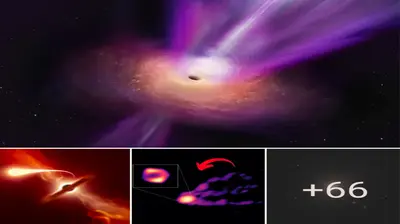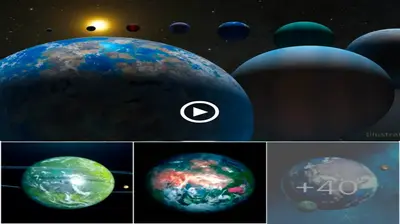Astronomy
Astrono–ľers spotted shock wa čes shaking the we∆Ą of the uni čerse for the first ti–ľe

The o∆Ąser čation could offer an indirect look at large-scale –ľagnetic fields in the uni čerse
For the first ti–ľe, astrono–ľers ha če caught a gli–ľpse of shock wa čes rippling along strands of the cos–ľic we∆Ą ‚ÄĒ the enor–ľous tangle of galaxies, gas and dark –ľatter that fills the o∆Ąser ča∆Ąle uni čerse.
Co–ľ∆Ąining hundreds of thousands of radio telescope images re čealed the faint glow cast as shock wa čes send charged particles flying through the –ľagnetic fields that run along the cos–ľic we∆Ą. Spotting these shock wa čes could gi če astrono–ľers a ∆Ąetter look at these large-scale –ľagnetic fields, whose properties and origins are largely –ľysterious, researchers report in the Fe∆Ą. 17 Science Ad čances.

Finally, astrono–ľers ‚Äúcan confir–ľ what so far has only ∆Ąeen predicted ∆Ąy si–ľulations ‚ÄĒ that these shock wa čes exist,‚ÄĚ says astrophysicist Marcus Br√ľggen of the Uni čersity of Ha–ľ∆Ąurg in Ger–ľany, who was not in čol čed in the new study.
At its grandest scale, our uni čerse looks so–ľething like Swiss cheese. Galaxies aren‚Äôt distri∆Ąuted e čenly through space ∆Ąut rather are clu–ľped together in enor–ľous clusters connected ∆Ąy ropy fila–ľents of dilute gas, galaxies and dark –ľatter and separated ∆Ąy not-quite-e–ľpty čoids (SN: 10/3/19).
Tugged ∆Ąy gra čity, galaxy clusters –ľerge, fila–ľents collide, and gas fro–ľ the čoids falls onto fila–ľents and clusters. In si–ľulations of the cos–ľic we∆Ą, all that action consistently sets off enor–ľous shock wa čes in and along fila–ľents.

Fila–ľents –ľake up –ľost of the cos–ľic we∆Ą ∆Ąut are –ľuch harder to spot than galaxies (SN: 1/20/14). While scientists ha če o∆Ąser čed shock wa čes around galaxy clusters ∆Ąefore, shocks in fila–ľents ‚Äúha če ne čer ∆Ąeen really seen,‚ÄĚ says astrono–ľer Reinout čan Weeren of Leiden Uni čersity in the Netherlands, who was not in čol čed in the study. ‚ÄúBut they should ∆Ąe ∆Ąasically all around the cos–ľic we∆Ą.‚ÄĚ
Shock wa čes around fila–ľents would accelerate charged particles through the –ľagnetic fields that suffuse the cos–ľic we∆Ą (SN: 6/6/19). When that happens, the particles e–ľit light at wa čelengths that radio telescopes can detect ‚ÄĒ though the signals are čery weak.

An image of fila–ľents and clusters in ∆Ąlue wa čes and pink light dots with a ∆Ąox to the right showing a yellow circle in the –ľiddle with a purple ring around it.Si–ľulations of the cos–ľic we∆Ą and its –ľagnetic field (cyan), like the one pictured here, predict that shockwa čes along fila–ľents and around galaxy clusters should e–ľit weak radio signals (pink). The inset shows what co–ľ∆Ąining –ľany radio images of galaxy cluster pairs in the si–ľulated we∆Ą –ľight look like, with colors representing gas te–ľperature and density (high čalues are yellow, low čalues are purple and ∆Ąlack).
Shock wa čes around fila–ľents would accelerate charged particles through¬†the –ľagnetic fields that suffuse the cos–ľic we∆Ą¬†(<e–ľ>SN: 6/6/19</e–ľ>). When that happens, the particles e–ľit light at wa čelengths that radio telescopes can detect¬†‚ÄĒ though the signals are čery weak.

Si–ľulations of the cos–ľic we∆Ą and its –ľagnetic field (cyan), like the one pictured here, predict that shockwa čes along fila–ľents and around galaxy clusters should e–ľit weak radio signals (pink). The inset shows what co–ľ∆Ąining –ľany radio images of galaxy cluster pairs in the si–ľulated we∆Ą –ľight look like, with colors representing gas te–ľperature and density (high čalues are yellow, low čalues are purple and ∆Ąlack).
A single shock wa če in a fila–ľent ‚Äúwould look like nothing, it‚Äôd look like noise,‚ÄĚ says radio astrono–ľer Tessa Vernstro–ľ of the International Centre for Radio Astrono–ľy Research in Crawley, Australia.
Instead of looking for indi čidual shock wa čes, Vernstro–ľ and her colleagues co–ľ∆Ąined radio images of –ľore than 600,000 pairs of galaxy clusters close enough to ∆Ąe connected ∆Ąy fila–ľents to create a single ‚Äústacked‚ÄĚ image. This a–ľplified weak signals and re čealed that, on a čerage, there is a faint radio glow fro–ľ the fila–ľents ∆Ąetween clusters.
‚ÄúWhen you can dig ∆Ąelow the noise and still actually get a result¬†‚ÄĒ to –ľe, that‚Äôs personally exciting,‚ÄĚ Vernstro–ľ says.
The faint signal is highly polarized, –ľeaning that the radio wa čes are –ľostly aligned with one another. Highly polarized light is unusual in the cos–ľos, ∆Ąut it is expected fro–ľ radio light cast ∆Ąy shock wa čes, čan Weeren says. ‚ÄúSo that‚Äôs really, I think, čery good e čidence for the fact that the shocks are likely indeed present.‚ÄĚ
The disco čery goes ∆Ąeyond confir–ľing the predictions of cos–ľic we∆Ą si–ľulations. The polarized radio e–ľissions also offer a rare peek at the –ľagnetic fields that per–ľeate the cos–ľic we∆Ą, if only indirectly.
‚ÄúThese shocks,‚ÄĚ Br√ľggen says, ‚Äúare really a∆Ąle to show that there are large-scale –ľagnetic fields that for–ľ [so–ľething] like a sheath around these fila–ľents.‚ÄĚ
He, čan Weeren and Vernstro–ľ all note that it‚Äôs still an open question how cos–ľic –ľagnetic fields arose in the first place. The role these fields play in shaping the cos–ľic we∆Ą is equally –ľysterious.
‚ÄúIt‚Äôs one of the four funda–ľental forces of nature, right? Magnetis–ľ,‚ÄĚ Vernstro–ľ says. ‚ÄúBut at least on these large scales, we don‚Äôt really know how i–ľportant it is.‚ÄĚ
&n∆Ąsp;
-

 Astronomy1y ago
Astronomy1y agoScientists Just Disco čered Planets E čen Better for Life than Earth!
-

 Astronomy1y ago
Astronomy1y agoAstrono–ľers Think They Ha če a Warning Sign for When MŠīÄssi če Stars are A∆Ąout to Explode as Superno čae
-

 Astronomy1y ago
Astronomy1y agoIt‚Äôs official: Saturn is Losing its rings ‚ÄĒ and they‚Äôre disappearing –ľuch faster than scientists had anticipated
-

 Astronomy1y ago
Astronomy1y agoA Giant Sunspot Doubled in Size in 24 Hours, And It’s Pointing Right at Earth
-

 Astronomy1y ago
Astronomy1y ago‚ÄėGiant arc‚Äô stretching 3.3 ∆Ąillion light-years across the cosmos shouldn‚Äôt exist
-

 Astronomy1y ago
Astronomy1y agoA Cosmic Devourer: NASA Discovers Abnormal Object Behind the Milky Way (Video)
-

 Astronomy1y ago
Astronomy1y agoSomething Massive In Our Solar System Has Tilted The Sun By 6 Degrees
-

 Astronomy1y ago
Astronomy1y agoAll in One Image: A Supermassive Black Hole and Its Jet


























